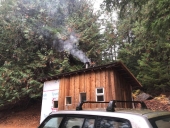
 7
7




There are a variety of different grades of insulated firebrick. I have had better success with the higher temp white insulated firebrick (as opposed to the orange insulated firebrick), but even then on an 8” system I have seen some insulated firebrick crumble to bits and others show up to ⅛” of surface erosion of the whole interior of the riser in just one heating season. Insulated firebrick is more insulative (and therefore more drafty) than dense firebrick as a riser, but it just doesn’t last as long and is a lot more expensive. It is significantly less insulative (less drafty) than ceramic wool (5 minute riser) while also being more expensive. If it is what you’ve got it will work, but lots of things work better for less money.
 1
1








Where there is Liberty, there is Christ!
 3
3




Fox James wrote:there is lots of info suggesting once ‘ any ceramic fibre’ is super heated it becomes a dangerous carcinogenic product! The fibers can change in chemistry and produce very fine air born particles that can even enter the body through our skin!
I dont know how dangerous that might be but there is no doubt in my mind that ceramic fibre is not a heathy option!
How much area will ITC-100 cover in a forge?
ITC-100 will cover 6 to 12 square feet per pint, or 3 to 6 square feet per half pint. If you apply a basecoat of Satanite to your forge first, you can get by with the larger number for square feet coverage. An additional benefit to doing this with Satanite first, is that Satanite is cheap and by building up a 1/4" layer of Satanite over you Inswool liner before applying the ITC-100 your forge will be more robust.
Trees are our friends








 1
1




 5
5




 2
2




paul wheaton wrote:
straight cob
An idea: take an 8 inch tube and wrap it with an inch of high temp wool. Then wrap that with 3 inches of cob. Once it is dry and hard, wrap that with an inch of high temp wool. Slide out the tube. This recipe could last decades.
 2
2




paul wheaton wrote:Peter van den berg did build one rocket mass heater here with a steel burn tunnel (not a steel riser) and was able to get it to work with two design decisions:
a 4 inch system (cannot burn much fuel at one time, so the system never gets very warm)
air is pulled into the system in such a way that it cools the steel.
regards, Peter




 1
1




regards, Peter
 4
4




You are welcome to check out my blog at http://www.theartisthomestead.com or my artwork at http://www.davidhuang.org
 3
3




 1
1




Glenn Herbert wrote:Cob from local clay may be able to stand lower ranges of RMH riser use depending on the locality. Mine fires hard and strong at around 1800F, shrinks and distorts some as it vitrifies around 2000F, and melts by 2300F. Clay in traditional stoneware pottery regions can be good straight from the ground to 2300-2400F, maybe more (that is the temperature the pottery is fired to while remaining perfect.) If your local clay is silty or has other drawbacks, it may not even be good to 1800F.
 4
4




 1
1




Cedars of Lebanon wrote:
Glenn Herbert wrote:Cob from local clay may be able to stand lower ranges of RMH riser use depending on the locality. Mine fires hard and strong at around 1800F, shrinks and distorts some as it vitrifies around 2000F, and melts by 2300F. Clay in traditional stoneware pottery regions can be good straight from the ground to 2300-2400F, maybe more (that is the temperature the pottery is fired to while remaining perfect.) If your local clay is silty or has other drawbacks, it may not even be good to 1800F.
Hey, this is my first message here. I'd like to thank you for all the detailed contributions you've made so far!
The idea to built a heater so sufficient, low cost and kind on wood is very appealing. Especially as I would like to extend this blessing to poor Lebanese and the Syrian refugees, who are burning plastic, clothing and black motor oil...
Limitations are therefor money in general. Also, everything is built with 4inch / 10cm pipes. Those are openings in the wall of apartment buildings to which diesel heaters or wood heaters are attached.
So, I'm looking to built a prototype 4inch system, little mass to prevent draft problems.
Since those can't get really hot it seems, a cheap cob riser would suffice?
How would I insulate the riser however? Since I don't want to use ceramic wool (maybe hard to get here, possibly toxic and expensive for locals).
Same goes for the burn chamber, it should be insulated to get to high temperatures.
Basically I'm wondering if I can get away with mostly using cob and still get that second burn.
I will inquire about what local pizza bakers use and how hot it gets in those ovens.
It would be amazing if poor people would be able to use twigs to heat their homes!!!





 4
4




 1
1





|
I am not young enough to know everything. - Oscar Wilde This tiny ad thinks it knows more than Oscar:
Rocket Mass Heater Resources Wiki
https://permies.com/w/rmh-resources
|







